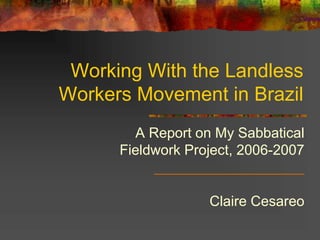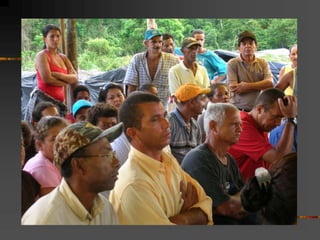Working with the Landless in Brazil
- 1. Working With the Landless Workers Movement in Brazil A Report on My Sabbatical Fieldwork Project, 2006-2007 ___________________ Claire Cesareo
- 2. My Field Site ’ü« I have been conducting research in the southern part of the state of Bahia, Brazil, for the past 15 years (see the map on the next slide). ’ü« The area in which I work has traditionally produced cacao, the fruit from which chocolate is made. ’ü« Within the past 15-20 years the market for cacao has dropped, so unemployment is very high and people are struggling to survive.
- 4. Cacao
- 5. Producing Cacao in Bahia ’ü« In Bahia, they harvest cacao and ferment and dry the seeds. ’ü« Most of this is exported to other countries that produce chocolate such as the U.S., Switzerland, and Belgium. ’ü« Today the harvesting of cacao has dropped down to a fraction of what it was in the past.
- 7. Cacao Seeds ŌĆō The Final Product
- 9. The Landless Movement ’ü« Since the year 2000 or so, an agrarian reform movement has emerged among the unemployed and underemployed of the region called the Landless Movement. ’ü« According to the Brazilian constitution, no one has a right to simply own farm land if they do not use it to produce. ’ü« There is a federal government process for people to petition to obtain ownership of unproductive land.
- 10. ’ü« In order to do this, people organize and set up encampments along the side of the major roads in the region. ’ü« They live in these camps, in small communities, until the government buys the farms for them. ’ü« In some cases, this process can take as long as five years.
- 11. ’ü« Following are pictures of some of the encampments I worked with in 2003.
- 22. HereŌĆÖs me with some of the people I got to know that summer.
- 26. Settlement Luanda ’ü« In the next group of slides are pictures of settlement where the people gained land and were starting to build their new lives.
- 38. Protest March ’ü« In 2003, all of the various landless groups met for a weekend seminar to discuss agrarian reform. ’ü« Following are pictures of a march that was held in the largest city of area ŌĆō Itabuna ŌĆō demanding that the government speed up the process of land appropriation and distribution, as well as the awarding of promised credits.
- 53. ’ü« The next set of slides deals with the research I did during my sabbatical year in 2006-2007.
- 54. The MTR Encampment ’ü« I worked primarily with one group called the Movimento dos Trabalhadores Rurais, or the the Movement of Rural Workers (MTR). ’ü« When I first arrived they had been encamped on the side of the road for close to five years.
- 56. Life in the Encampment ’ü« In these encampments, there is no running water or sanitation system. ’ü« People need to get and carry water from a nearby stream and gather firewood for cooking.
- 60. The Dangers of Living on the Side of the Road ’ü« In the next slide, you can see how close to the road they actually are located. People travel along this road going 50 or 60 mph, making it quite dangerous, especially for the many kids that live in these encampments. ’ü« In addition, the landless are often insulted by people driving by who call them ŌĆ£bums,ŌĆØ ŌĆ£scumbags,ŌĆØ and ŌĆ£lazy good-for- nothings.ŌĆØ
- 63. ’ü« Because they are living under a plastic covering only, the rain often soaks in and turns the dirt floor of their shacks into mud.
- 69. Solidarity ’ü« Among the families living in this encampment, there was a tremendous amount of solidarity. They shared food and laughter, as well as a common sense of purpose.
- 78. Pressuring the Government ’ü« After a few months of my arrival in Brazil, a few of us drove 7 hours to the government agrarian reform offices to put pressure on them. ’ü« While there, we received the news that the farm would be paid for the next day and they would be able to move onto it within the next few weeks.
- 83. Moving Day ’ü« The next group of slides show the day people packed up all their belongings, dismantled the encampment, and moved onto their own farm. ’ü« This happened 5 years, 3 months, and 1 day after the encampment was established.
- 96. Fazenda Rochedo ’ü« The next set of pictures show the farm of close to 1000 acres that would be divided among the 30 families of the encampment.
- 101. ’ü« You can see by the next few slides, that the farm had not been taken care of for years. ’ü« All of the existing housing was falling apart. Eventually these will be renovated, but for the time being people had to try to make them livable and build new shacks.
- 107. Often, my children were with me doing fieldwork.
- 108. Victory March ’ü« The families held a march in the nearest city to publicize their victory.
- 111. Building the Future ’ü« The next slides show the families as they worked to build their futures together.
- 135. The Anthropologist as Godparent ’ü« Many times anthropologists are asked to be godparents for the children of their informants. ’ü« I became the godmother of beautiful twin girls.
- 138. A New Encampment ’ü« At the edge of Fazenda Rochedo, a new encampment of 150 families was built. ’ü« They will need to win at least four farms to accommodate all of these families.
- 147. My Godchildren
- 156. My Shack at the Encampment ’ü« The next couple of slides are pictures of the shack that I built to stay in while doing fieldwork at the encampment. ’ü« I did not live here fulltime, but would often spend the weekends here.
- 172. The Future ’ü« The next few years for these families will not be easy. However, at least they have the hope that they will no longer be dependent on the little wage labor that still exists in the region and can create a better future based upon small, sustainable, farming.
- 173. Some Questions You Might Want to Consider ’ü« What can an anthropologist do when working with people who need a lot of assistance? What kind of help can they offer? ’ü« What kinds of methods do you think I used while in the field? ’ü« What would be the kinds of things you would be interested in knowing about this group of people? What things should I have investigated and what questions should I have asked?












































































































































































